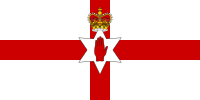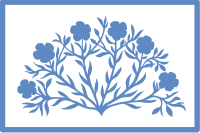Flag of Northern Ireland facts for kids
In Northern Ireland, the only official flag is the Union Flag. This flag represents the United Kingdom. However, different groups in Northern Ireland identify with different flags. This often causes disagreements and is a big issue.
The Ulster Banner was used by the Northern Ireland government from 1953 to 1973. After 1973, the government and parliament were stopped. So, the Ulster Banner is no longer official. But many loyalists and unionists still use it. They use it to show their support for Northern Ireland. It also represents Northern Ireland in some international sports.
The Saint Patrick's Saltire is part of the Union Flag. It represents Ireland within that flag. Sometimes, people fly it during Saint Patrick's Day parades. It is also used for Northern Ireland during some royal events.
Recently, people have suggested a new, neutral flag for Northern Ireland. This idea came from a special group in December 2021.
Contents
The Ulster Banner: Northern Ireland's Former Official Flag (1924–1973)
The Ulster Banner is also known as the "Red Hand Flag." It was given to the Government of Northern Ireland in 1924. This was done through a special permission called a royal warrant. Like other British flags, its official status was not set in law.
The Government of Northern Ireland received its own coat of arms. They could display these arms on a flag. They first did this for the Coronation of Queen Elizabeth II in 1953. The banner was flown over Parliament Buildings. On July 1, 1953, a government minister said the Union Flag was the only official flag. But he also said people could use the Ulster Banner as a symbol for Ulster.
When the Parliament of Northern Ireland was closed down in 1973, the flag stopped being used officially. However, it is still the only flag that represents Northern Ireland in international sports today. Since the government was abolished, loyalists have used the Ulster Banner even more.
Official Flag Use in Northern Ireland
Public buildings in Northern Ireland follow rules for flying flags. The Flags Regulations (Northern Ireland) Order 2000 states that the Union Flag must be flown. This happens on specific days, like the Queen's official birthday. These are called 'named days'.
When the British Monarch visits a government building, the Royal Standard is flown. The Union Flag can also be flown. If another country's leader visits, the Union Flag and their country's flag can be flown. On Europe Day, the flag of Europe should be flown with the Union Flag if there are two flagpoles. These rules say that no other flags can be flown from these buildings.
Sometimes, at official events, Northern Ireland is represented by the St. Patrick's Cross. This happened on the boat Gloriana during the 2012 Thames Diamond Jubilee Pageant. In 2016, the Ulster Banner was flown during a special event for the Queen's 90th birthday. It was flown alongside the flags of England, Scotland, and Wales.
The Police Service of Northern Ireland has its own flag rules. They are only allowed to use their own flag.
Local Councils and Flags
Rules about flag flying do not apply to local council buildings. So, different councils do different things. Some councils, like Lisburn, fly the Union Flag every day. Others fly no flags at all. Some only fly their council flag. Others follow the same rules as government buildings.
In 2004, Belfast City Council studied flag flying. They found that three councils flew the Ulster Banner alongside the Union Flag. These were Ards Borough Council, Carrickfergus Borough Council, and Castlereagh Borough Council. These councils were later changed.
Northern Ireland in International Sport
The Ulster Banner is used to represent Northern Ireland in many sports. It is used for the Northern Ireland team at the Commonwealth Games. Golfers on the PGA Tour also use it. And FIFA uses it for the Northern Ireland national football team.
Displaying Flags and Community Identity
In Northern Ireland, flags are used to show political beliefs. They also mark areas that different groups identify with. Unionists and loyalists fly the Union Flag and Ulster Banner. This shows their support for staying part of the UK. Irish nationalists and republicans fly the Irish tricolour. This shows their support for a United Ireland.
Flags and the Peace Process
After the 1998 Good Friday Agreement, flags continued to cause problems. The Agreement said that symbols should be used to promote respect, not division.
All participants acknowledge the sensitivity of the use of symbols and emblems for public purposes, and the need in particular in creating the new institutions to ensure that such symbols and emblems are used in a manner which promotes mutual respect rather than division.
Nationalists argued that the Union Flag should be used less. They also wanted the Irish tricolour to be flown with the British flag on government buildings. Some ministers tried to stop the Union Flag from flying on buildings their departments ran. But a new law in 2000 stopped them from doing this.
All groups who signed the Good Friday Agreement agreed that Northern Ireland's status would only change if most people voted for it. Unionists said this meant the Union Flag was the only official flag. The flag issue was discussed a lot, and new flag ideas were suggested.
In 2013, a US diplomat named Richard Haass led talks about flags. His ideas included creating a new flag for Northern Ireland. This new flag would replace the Ulster Banner. However, the political parties did not agree on these proposals.
See also
 In Spanish: Bandera de Irlanda del Norte para niños
In Spanish: Bandera de Irlanda del Norte para niños





